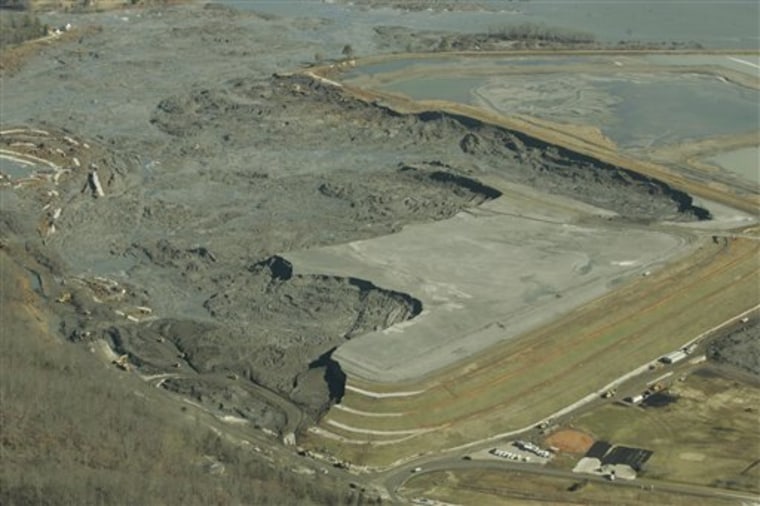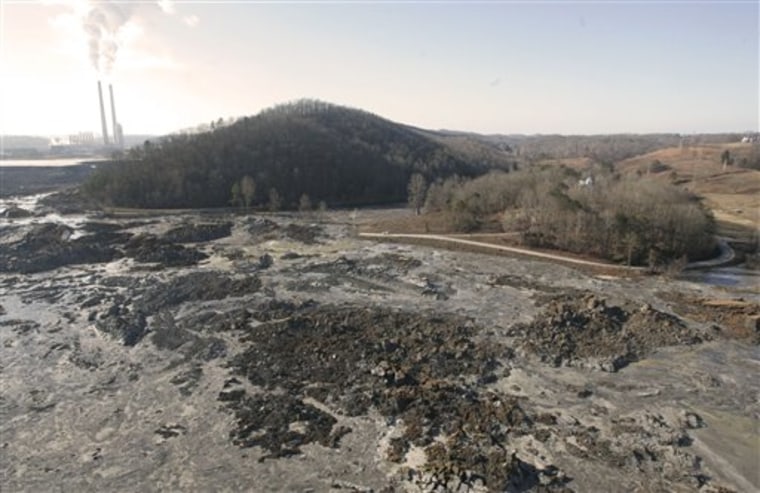A week after more than a billion gallons of coal ash broke through a retention pond dike and roared into a small river cove, the landscape has turned into a muddy pit that's little like the scenic spot that attracted people to live here.
The Emory River is clogged with giant chunks of gray ash sticking out of the water and trees ripped out by their roots and washed downstream during the Dec. 22 disaster. Ducks float in a film of sand-like residue on the surface. Dozens of pieces of heavy equipment are digging along the river to try to clean it of coal ash.
The Kingston Steam Plant, a coal-fired power plant operated by the Tennessee Valley Authority, sits on the confluence of two rivers, about 35 miles west of Knoxville.
The deluge destroyed three houses, displaced a dozen families and damaged 42 parcels of land, but there were no serious injuries.
There are 62 pieces of heavy machinery slowly gathering up the spilled ash from residential roads, railroad tracks and the river, plant manager Ron Hall said Monday.
But no one at TVA can say how long the cleanup will take and how thorough the restoration can be.
"It's almost like someone dying, because it's so permanent," said Crystell Flinn, whose home was swept away.
New ponds not likely
Hall said workers will pull the sludge out of the river using barges and skimmers, and dump trucks will carry it to a different site at the plant. But the material won't return to the large riverside retention ponds still there.
"We will not likely put in wet ash ponds again, even though they have shown to be structurally integral," TVA environmental executive Anda Ray said Monday. "We are looking at options for what to do long term for that ash disposal, but there are dry ash pond technologies."
In the days after the spill, officials are finding more reasons to be concerned about the possible harmful long-term effects. Federal officials on Monday cautioned residents who use private wells or springs to stop drinking the water.
But the area isn't densely populated, and TVA said that no more than four wells are in the spill area.
Samples taken near the spill slightly exceed drinking water standards for toxic substances, and arsenic in one sample was higher than the maximum level allowed for drinking water, according to a press release from TVA, the Environmental Protection Agency and other agencies.
Federal officials should have tests on the affected wells sometime this week.
"I think they (the wells) were beyond the actual slide point of the material," EPA spokeswoman Laura Niles said. "There shouldn't be direct impact, but that's why they are sampling."
Authorities have said the municipal water supply is safe to drink.
Arsenic occurs naturally in the environment, but elevated levels can cause ailments ranging from nausea to partial paralysis, and long-term exposure has been linked to several types of cancer, according to the EPA.
Ray said arsenic levels were high because of the type of measurement that the EPA used, which included soil mixed in with water.
"Those samples were not dissolved arsenic," Ray said. "The dissolved arsenic, which is what you look at for drinking water samples, are undetectable in all the cases. The elevated arsenic that the EPA is referring to is the data that we collected when it was stirred up. It is routinely filtered out through all water treatment plants."
Dust concerns
Environmental concerns could shift when the sludge containing the fly ash, a fine powdery material, dries out. The EPA and TVA have begun air monitoring and on Monday advised people to avoid activities that could stir up dust, such as children or pets playing outside.

The dust can contain metals, including arsenic, that irritate the skin and can aggravate pre-existing conditions like asthma, Niles said.
The EPA recommends that anyone exposed to the dust should wash thoroughly with soap and water and wash the affected clothes separately from other garments.
Ray said TVA will start installing sprinkler systems in areas where the ash has dried out to keep it moist.
Knoxville-based TVA supplies electricity to Tennessee, Mississippi, Alabama, Kentucky, Georgia, North Carolina and Virginia.
